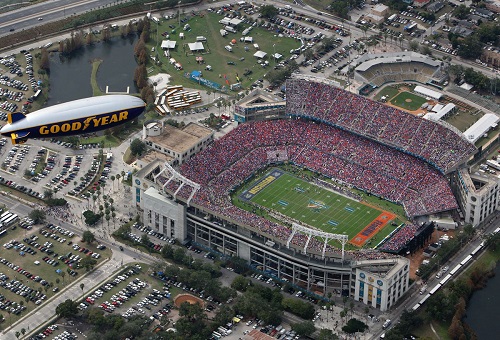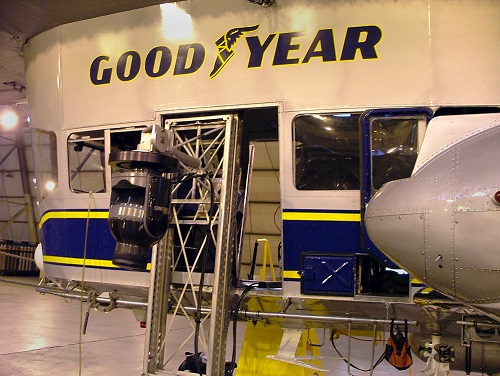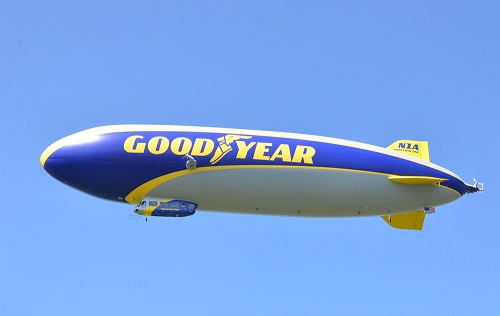Goodyear Covers Events With New Aerial Platform
ALEXANDRIA, Va.―We've all seen the Goodyear Blimp on TV at big events, such as playoff games, the Super Bowl and other high-profile televised affairs. Not only does the blimp promote Goodyear, but it becomes a video platform that gives producers an aerial vantage point, adding an aura of "bigness" to the event. After all, you wouldn't expect to see the Goodyear Blimp at the opening of a new DMV office.
A brilliant bit of marketing that has become a staple of television coverage, the Goodyear Blimp has been flying and promoting the company since 1925, and for the past few decades also performing a valuable role in the production of big events. The concept was so smart that other companies launched their blimps to catch the same awe and marketing punch as the Goodyear Blimp. Fuji Film and Met Life are two examples of companies that have had their names plastered on the side of blimps.

A Goodyear Blimp covers the 2007 Capital One Bowl in Orlando, Fla. However, beyond knowing that the Goodyear Blimp is often in the sky at major television events, background on how the blimps work for video production is a little harder to come by. With the launch of a new Goodyear Blimp in August, it seemed like a good time to find out how the airships perform their video duties.
First, the "Goodyear Blimp" is actually a fleet of three airships, with the newest one (Wingfoot One) technically a semi-rigid airship and not a blimp. Together, Goodyear officials expect the three blimps to cover 160 events in 2014.
"The process for booking events can either be initiated by Goodyear or the network," said Doug Grassian, senior manager for airship communications at Goodyear in Akron, Ohio. "We get requests all the time, as you can imagine, and we would love to accommodate them all but we just can't. There are also opportunities that we explore that we know are of high value to Goodyear, and we are proactive with the networks to try to lock those down."
It takes Grassian and his crew roughly an hour to install the camera and ancillary equipment on the ship. On site at the event, they set up the microwave gear that carries signals from the ship to the network television production truck. That set-up process takes a couple of hours typically but sometimes it can take more depending on the venue layout, magnitude of the event and other factors. For some events, the Goodyear team sets up the equipment the day before and provides a test run for the network, to make sure all of the equipment is locked in and delivering a high-quality product.
TYPICAL EQUIPMENT
Get the TV Tech Newsletter
The professional video industry's #1 source for news, trends and product and tech information. Sign up below.
The typical equipment complement starts with an Axsys Technologies' Cineflex V14 gyro-stabilized pan/tilt head that can also rotate. The Cineflex V14 has an integrated Sony HDC-1500 camera and Fujinon 9.7x42 lens with a 2X extender. Inside the ship, there's a Sony PVM-1741A HD monitor and a Tektronix WFM5200 waveform monitor for the camera operator. A Sony PDW-HD1500 HD video recorder captures the feed for safe-keeping. For the microwave downlink, Goodyear uses Janteq and Nucomm microwave transmitters and receivers, with Gigawave antennas picking up the signal at the production truck.

The Cineflex V14 gyro-stabilized head has an integrated Sony HDC-1500 camera and Fujinon 9.7x42 lens with a 2X extender. Grassian said that his team is evaluating 4K camera/downlink options, although that ultimately depends on what the TV network requests.
"We would like to be ahead of the game so we can deliver the best quality product to our network partners," Grassian said.
When you see the Goodyear Blimp floating elegantly above a football stadium, you might not realize that it can be up in the air for 10 hours on a single shoot. Amenities (such as a lavatory and galley) are surprisingly not available in the older airships.
"The new blimp, Wingfoot One, has a restroom facility and the crews are prepared for long flights and know how to properly take care of themselves," Grassian said.

Wingfoot One takes to the sky after its christening in August 2014.FUTURE OF THE FLEET
Speaking of Wingfoot one, Grassian sees it as the future of the fleet.
"Wingfoot One offers an ideal model to provide aerial coverage and [Goodyear] will slowly phase out our existing GZ-20 models," he said. "The benefits of the flight design―vectored engines that allow the ship to hover in place―has serious benefits for aerial coverage."
In addition to the ability to hover, Wingfoot One is also considerably faster than the company's two older airships―it can fly between shoots in a day on routes that take two days for the older models. Its propulsion is provided by surprisingly small engines, considering the 246-foot length and 65-foot width of Wingfoot One: It has three 200-horsepower engines.
Not every request can be accommodated by a Goodyear Blimp, although the company will sometimes go out of its way to satisfy its network customers.
"We provided the aerial coverage for the World Cup in Brazil," Grassian said. "We did this with a helicopter, as we were unable to get a blimp down to the area in the timeframe needed. The challenges of providing aerial coverage in another country are significant but we were able to work through them and provide excellent pictures to ESPN."
Bob Kovacs is the former Technology Editor for TV Tech and editor of Government Video. He is a long-time video engineer and writer, who now works as a video producer for a government agency. In 2020, Kovacs won several awards as the editor and co-producer of the short film "Rendezvous."

